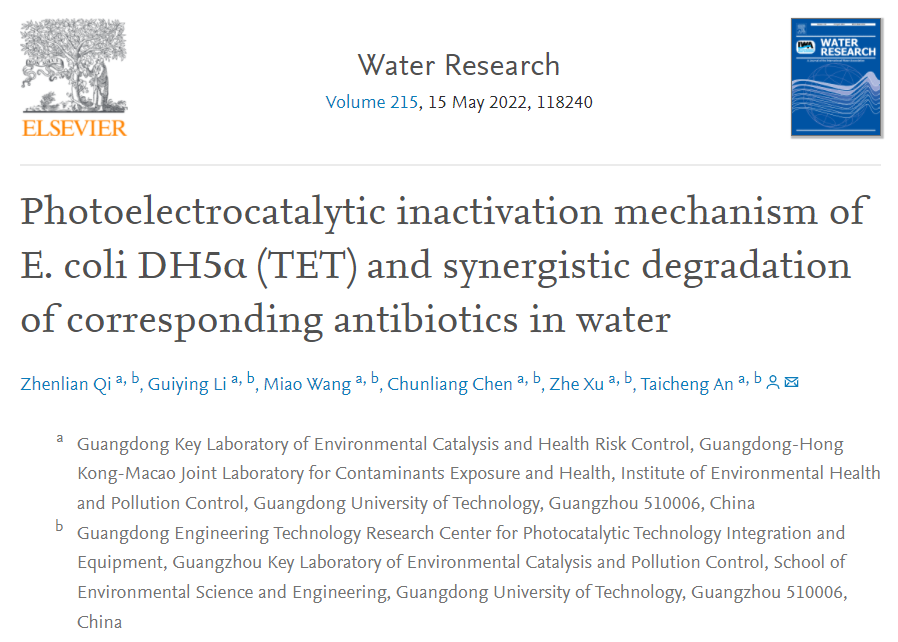近日,广东工业大学环境健康与污染控制研究院、环境科学与工程学院安太成教授团队题为《Photoelectrocatalytic inactivation mechanism of E. coli DH5α(TET) and synergistic degradation of corresponding antibiotics in water》的学术论文在国际水质学会会刊Water Research(2022, 215: 118240)杂志上发表。论文的第一作者为博士后亓振莲,通讯作者为安太成教授。该研究主要关注耐药细菌(ARB)的光电催化灭活机理及相应抗生素在水中的协同降解机制,揭示了共存的抗生素会抑制光电催化灭活过程,并协同诱导某些ARB细胞进入活的但不可培养的细菌细胞(VBNC)状态,导致活性耐药基因(ARG)残留继续传播的潜在风险。该研究呼吁根据该论文的研究成果对水处理技术过程进行适当的调整,以确保饮用水安全。

论文DOI:https://doi.org/10.1016/j.watres.2022.118240
耐药基因(ARGs) /耐药细菌(ARB)的增殖和传播逐渐演变成一个全球性问题。特别是在COVID-19疫情暴发等特殊时期,ARB/ARGs通过污水渠道的传播随之加剧,严重危害生态环境和人类健康。据报道:即使是微量水平的抗生素残留,也有可能诱导抗生素耐药性并促进ARB/ARGs的增殖扩散。抗生素残留与ARB/ARGs在水环境中普遍共存,如医疗废水、市政污水等。目前使用的抗生素大约48%用于人类,其余用于动物,大多数抗生素在体内没有完全代谢,导致在水环境中检测到的抗生素残留(如红霉素、土霉素)浓度水平从几十ng/L到数百μg/L。在医疗废水中,抗生素残留水平甚至达到数百mg/L。这引发了世界范围内微生物耐药菌株不断增加和ARB/ARGs的高风险传播。在此背景下,迫切需要研发安全有效的水净化技术消除ARB/ARGs及共存的抗生素。由于ARB/ARGs与抗生素的相互作用在水净化过程中不可避免地发生,为了明确其协同净化机制,本研究以光电催化(PEC)为模型,系统地研究了含四环素抗性基因的耐药细菌E coli.DH5α (TET)的灭活与对应盐酸四环素(TET)抗生素协同降解作用的机理。
本研究结果表明:单独用PEC处理E coli.DH5α (TET)可通过增加细胞内ROSs的积累以破坏细胞氧化还原平衡而致其死亡。同时,E coli.DH5α (TET)的防御系统倾向于增加超氧化物歧化酶(SOD)和谷胱甘肽过氧化物酶(GSH-Px)的抗氧化活性以应对氧化性刺激。共存TET主要是通过对氧化性物质如空穴(h+)、羟基自由基(•OH)和超氧自由基和氧(O2•-)竞争实现降解,而主要通过对h+和O2•-的竞争抑制ARB/ARGs的失活。特别值得关注的是,PEC与TET协同作用可能会促进某些ARB细胞转化为VBNCs,导致活性ARG残留及其继续传播的潜在风险。虽然有些方面的机制仍不清楚,但是如何正确评估ARB/ARGs的失活和共存抗生素降解的协同作用机制值得深入探究,以避免低估抗生素耐药性在水环境中传播的风险。
论文网址:https://doi.org/10.1016/j.watres.2022.118240
图文摘要:

论文的英文摘要附如下:
ABSTRACT:
The occurrence and proliferation of antibiotic-resistance genes (ARGs) / antibiotic-resistant bacteria (ARB) have been currently aggravating due to the increase of antibiotic residues in the aquatic environment. The interaction of ARB/ARGs with antibiotics inevitably occurred during water purification, yet their synergistic purification mechanism remains unclear. Herein, a systematic approach was developed to understand, in-depth, the synergistic mechanism in the coexisted E. coli DH5α (TET) inactivation and tetracycline hydrochloride (TET) degradation using photoelectrocatalysis (PEC) as a model technology. Results showed that low dosage (0 – 40 ppm) of TET exerted a negative influence on ARB inactivation with prolonged bactericidal time from 60 to 160 min. Addition of TET in environmental concentration (5 – 60 ppm) resulted in sub-lethal damage and prolonged PEC treatment time (100 – 160 min), accounting for inhibition effects on ARB inactivation. The major reactive species (RSs) involved in ARB inactivation and TET degradation were evidenced as photogenerated hole, •OH and O2•−, whereas hole and O2•−were demonstrated to be the major disinfectants for ARB/ARG inactivation. The bacterial defense system displayed increased antioxidative activities of superoxide dismutase (SOD) and glutathione peroxidase (GSH-Px) to protect ARB cells against oxidative stress. Exposure to 60 ppm TET was a threshold where certain ARB cells were induced into viable but nonculturable bacterial cell (VBNC) state, as evidenced by plate counting and ATP activity analysis, together with the integral cell membranes observed by flow cytometry (FCM) and scanning electron microscope (SEM). These findings appeal for appropriate technical adjustments for water and wastewater treatment to ensure safety of water.